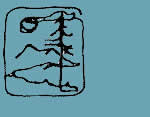
| go to winter quarter |
| home |
| announcements |
| syllabus |
| assignments |
| resources |
| contacts |
 |
|
Perception
Fall 2003 (continued in Winter 2004)
Program
Description - Fall 2003
Thad Curtz, Ph.D (Literature and Developmental Psychology)
Nancy Murray, Ph.D. (Molecular Biology)
Charles Pailthorp, Ph.D. (Philosophy and Music)
This
full time first year program integrated work in biology, developmental
psychology, anthropology, and the humanities to explore the neurological
bases of smell and hearing; their historical and cultural variation;
and practical and theoretical issues about the interactions between
concepts, language, and perception in science, art, and the lived experience
of children and adults. Each week, we met for four hours of lecture
and workshop, a two hour lab, four hours of seminar discussion, and
three hours of film screening and discussion; students also spent three
hours a week observing in a grade school classroom.
They wrote two short pieces a week, an exercise about the main points
or themes of the week’s main text and a three to five page expository
paper about it, on a topic of their own. In this sequence we read three
essays from Sacks’s An Anthropologist on Mars and “A
Dog Beneath the Skin;” Dillard’s Pilgrim at Tinker Creek;
Burr’s The Emperor of Scent; Stoddart’s The
Scented Ape: The biology and culture of human odor; Classen, Howes
and Synnott’s Aroma: The Cultural History of Smell; Suskind’s
Perfume; the first half of Ong’s Orality and Literacy;
Peters’s Here-Ings: A Sonic Geohistory; Feld’s
Sound and Sentiment: Birds, Weeping, Poetics, and Song in Kaluli
Expression; Howes’s “Olfaction and Transition,”
Schafer’s The Soundscape: The Untuning of the World;
and Hull’s Touching the Rock: An Experience of Blindness.
In most weeks, we viewed and analyzed a film dealing with our themes:
Truffaut’s The Wild Child, Herzog’s Every Man
for Himself and God Against All: Kaspar Hauser, Doillon’s
Ponette, Jeunet and Caro’s Delicatessen, Campion’s
The Piano, and Aronson’s Sound and Fury. Students
also wrote a mid-term exam integrating our work.
Students attended a weekly lecture on the neurobiology and anatomy of
the olfactory and auditory systems, supplemented by chapters from Rodieck's
The First Steps in Seeing on neurons and Purves et al's Neurobiology
on the auditory system. In accompanying weekly laboratory sessions they
did experiments and kept a lab notebook exploring sensory phenomena
such as olfactory fatigue and afterimages, mapping the somatosensory
cortex through two-point discrimination testing, and factors affecting
sound location. Each student also did independent research on an unusual
kind of perceptual experience of their choice, writing a final paper
and giving a fifteen minute presentation to the class.
For
our work in epistemology and developmental psychology, students read
selections from Descartes and Locke, Piaget’s “How Children
Form Mathematical Concepts,” Anderson and Smith’s “Children’s
Preconceptions and Content-Area Textbooks” and Roth, Smith, and
Anderson’s “Verbal Patterns of Teachers: Comprehension Instruction
in the Content Areas,” several chapters on stages from Wadsworth’s
Piaget’s Theory of Cognitive and Affective Development,
and Perry’s “Cognitive and Ethical Growth: The Making of
Meaning.”
Suggested Credit Equivalencies (in quarter credit hours): 16
4 – Freshman Humanities Seminar
4
– Expository Writing
3 – Biology of the Senses
3 – Introduction to Piaget
2
– Independent Research